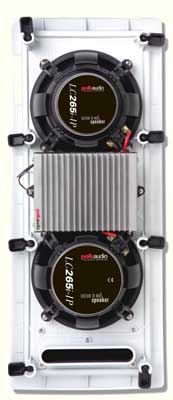|
||||||||
|
Introduction I should have known I was in trouble early, when Paul DiComo, Polk Audio's Master Marketing Manager, e-mailed me with an offer to review a new in-wall speaker. I had the opportunity to review an entire in-wall speaker surround setup from Polk, namely their LC65i, in February of 2005. Back then I became a believer that in-walls could deliver a pretty good punch – both for home theater and for music. This was a little different when he offered to deliver it himself from their headquarters in Baltimore a short jaunt down the Turnpike from me. My first question to him was, "What are we talking about?" After all, I had already placed five pre-built walls 2 ft wide x 8 ft tall from Paul in my modestly sized living room. How bad could it be? His response was, "I'll get back to you on that." Paul arrived on a nice Saturday morning with a van; in it were two familiar full height walls with in-wall speakers already installed. Next came out what I'll refer to as the big black box on wheels. Removing the front and rear panel revealed a number of component pieces, most importantly was the Audio ReQuest music server, a power supply, and various NetStreams switchers and outlets, none of which are the subject of this review. What Paul wanted me to spend time auditioning was in the 7 ft walls – the new LC265i-IP speaker, and because the system can handle multiple zones, he brought along another pair of Polk speakers called the Atrium 60, which look like substantial outdoor speakers, but more on them later. Of course the entire thing is meant to simulate a whole-house system, only without the house. The System Listening to these speakers isn't as simple as it sounds. There are three components brought together for you to hear anything. Polk partners with NetStreams and using their DigiLinx distribution system allows for a multi-room entertainment setup. The third component is the ReQuest music server with a significant hard drive. Since the amplifiers are built into the Polk speakers, other than switches and cables, no other equipment is necessary. If you want to bypass the ReQuest music server, the system allows for an outside source like a CD player. All the control is done either through a NetStreams LCD touch screen controller which would typically be mounted on a wall or via your computer using the DigiLinx software. Other methods are possible, but more on that later too.
Polk audio touts its new LC265i-IP as the "world's first" active IP addressable loudspeaker. Before I get to the uniqueness of this in-wall, let's get familiar with the construction. I will be referring to it as the 265. The unit is about 8" wide by 20" tall and is designed to fit in a typical wall stud construction at a bit over 3" deep, and weighs in at almost 9 lbs. The 265 is a three-way design with a three-channel power amplifier built right into the back of the speaker. The amplifiers have a total of 200 watts, with 100 watts to the woofer, 75 watts to the midrange, and 25 watts to the tweeter. A 48V DC power supply is necessary to run the 265. For that, Polk has the SPS-1 unit, currently unavailable for this review, but it's expected to deliver the 4.0 amperes required by each 265, and in fact can deliver up to 40 amps. None of drivers are new for the 265; in fact I recognize many of the same features I found in the LC65i last year. A quick look reveals the familiar swivel mounted 1" ring radiator tweeter, two 6 ½" polypropylene drivers, and the Polk "Power Port". The immediate similarities end there, flip the speaker over and the obvious addition is the amplifier. An air-injected mineral-filled aerated polypropylene driver is said to be stiffer in cross-section. The softer interior provides damping, while the harder exterior provides stiffness. By lightening the structure of the Polk driver, it becomes quicker and therefore more detailed. The molded rubber outer surround is used to control those pesky "stray resonance waves" and deaden the results before they ever reach your ears. The 1" tweeter can swivel up to 15 degrees, aiming towards the listening position. The Polk Power Port is essentially an opening aiding the speaker to control turbulence which plays havoc with bass. The port facilitates a natural airflow and reduces distortion. Innovation for these in-walls continues with the built-in DSP and seven-band parametric room EQ. Installing the software (Polk cleverly named it the "Performance Optimization Wizard") in your computer, Polk takes you through a series of questions for room adjustments (more about that later). Once you've completed the setup, save it, and the speakers will perform as instructed. Playing with various options allows you to store as many configurations as you'd like. This is especially important, because the server you use may actually have many rooms, and each can have its own setup. After that, your only options are to adjust bass, mid, and treble via the control pad, or computer.
|
||||||||


 The LC265i-IP
The LC265i-IP

